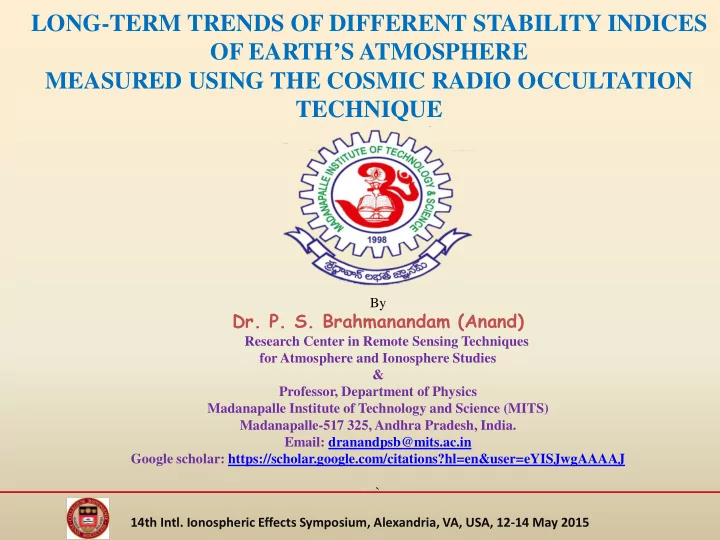

LONG-TERM TRENDS OF DIFFERENT STABILITY INDICES OF EARTH’S ATMOSPHERE MEASURED USING THE COSMIC RADIO OCCULTATION TECHNIQUE By Dr. P. S. Brahmanandam (Anand) Research Center in Remote Sensing Techniques for Atmosphere and Ionosphere Studies & Professor, Department of Physics Madanapalle Institute of Technology and Science (MITS) Madanapalle-517 325, Andhra Pradesh, India. Email: dranandpsb@mits.ac.in Google scholar: https://scholar.google.com/citations?hl=en&user=eYISJwgAAAAJ ` 14th Intl. Ionospheric Effects Symposium, Alexandria, VA, USA, 12-14 May 2015
Contents INTRODUCTION- ATMOSPHERIC INDICES FEW VALIDATION STUDIES & ANALYSIS PROCEDURE GLOBAL TRENDS & MAGNITUDES OF CAPE DIURNAL VARIATIONS OF CAPE CIN GLOBAL TRENDS MONTHLY VARAITIONS OF CAPE AT DIFFERENT LOCATIONS CONCLUSIONS 14th Intl. Ionospheric Effects Symposium, Alexandria, VA, USA, 12-14 May 2015
INTRODUCTION- ATMOSPHERIC INDICES Determination of atmospheric indices is imperative to assess the instability nature of earth’s weather, which are often useful in the forecasting and nowcasting of intense convective and severe weather (thunderstorms and lighting) Although several new atmospheric indices are being continually introduced and evaluated, one can find a list of indices in the literature, including Showalter index (SI, Showalter, 1953), lifted index (LI, Galway 1956), convective available potential energy (CAPE, Moncrieff and Miller 1976), convective inhibition (CIN, Romero et al., 2007) and etc. vertically integrated indices, including CAPE, CIN are being widely used by the community when compared with single-level stability indices including, SI and others. In order to carry out analysis and forecasting of severe weather associate with convective precipitation, both CAPE and CIN indices are often used. 14th Intl. Ionospheric Effects Symposium, Alexandria, VA, USA, 12-14 May 2015
FEW VALIDATION STUDIES & ANALYSIS PROCEDURE
GLOBAL TRENDS OF CAPE OBSERVATION : CAPE values are following a wave-like pattern during 2007-2012. More clearly, higher (lower) values are found to be located in northern (southern) hemisphere during JJA and SON (DJF and MAM) seasons, which directly implying that the CAPE trends are following inter-tropical convergence zone (ITCZ) where large moisture values often present. IT IS, THEREFORE, POSSIBLE TO TRACK THE EVOLUTION OF ITCZ INDIRECTLY (BY CALCULATING CAPE VALUES) DURING DIFFERENT SEASONS (!) Figure shows longitude vs. latitude structures of CAPE (measured in J/kg) during four seasons (left to right) during 2007 and 2012
Magnitudes of CAPE Quantification of CAPE -Aviation field. Unexpected convection over oceans can adversely affect airplane travel and the Federal Aviation Agency (FAA) of the USA is trying to develop techniques that warn of imminent convection (Donovan et al., 2007). FAA has decided to use CAPE as a potential useful meteorological index (Donovan et al., 2007) Figure shows a bar graph of CAPE magnitudes during four seasons
DIURNAL VARIATIONS OF CAPE OBSERVATION: Diurnal variations of CAPE also show a wave-like pattern during 2007-2012. Maximum values are found during daytime hours, particularly around between 0600 and 0900 LT and around between 1300 and 1500 LT. Minimum values are found during nighttime hours (around between 2100 and 0400 LT) in different seasons No solar activity is found. Figure shows local time vs. latitudinal variations of CAPEs during MAM, JJA, SON and DJF seasons (left to right panels) between 2007 and 2012 14th Intl. Ionospheric Effects Symposium, Alexandria, VA, USA, 12-14 May 2015
GLOBAL TRENDS & MAGNITUDES OF CIN CAPE DESCRIBES THE POTENTIAL BUOYANCY AVAILABLE TO IDEALIZED RISING AIR PARCELS, CONVECTIVE INHIBITION (CIN) DESCRIBES A STABLE SURFACE LAYER Figure shows CIN seasonal trends at tropics for different seasons, including a) March equinox b) June solstice c) September equinox, and d) December solstice in 2007 Observation: a) A near bimodal distribution in CIN trends, with minimum values at around the geographic equator and maximum values at around 10 0 -15 0 latitudes on both sides of the equator As air transports to pole ward and descends along the lower latitudes latitude, wherein CIN (CAPE) associated with higher (lower) values (!)
Monthly variations of CAPE at Delhi and Kolkatta Observation: Higher CAPE values are observed around July-September period during majority of years consistently, a time at which the monsoon is active in northern India Figure shows monthly variations of CAPE near Delhi (28.30 N, 77.10 E) during 2007- 2012 Observation: Higher CAPE values are observed around June-August period during majority of years consistently. Earlier CAPE peak values near Kolkata can be justified based on the fact that the onset time of monsoon in eastern part of India is Figure shows monthly variations of CAPE near Kolkatta (22.30N, earlier than northern part 88.20E) during 2007- 2012 14th Intl. Ionospheric Effects Symposium, Alexandria, VA, USA, 12-14 May 2015
CONCLUSIONS Wave-like feature in CAPE seasonal and diurnal trends is noticed consistently, by confining to the northern (southern) hemisphere during June solstice and September equinox (December solstice and March equinox) seasons It may be possible to track the evolution of the ITCZ indirectly (by calculating CAPE values from COSMIC RO data) during different seasons CAPE trends seem to be following ITCZ movements, which are again confirmed by analyzing OLR database during different seasons Maximum CAPE values are observed during daytime, while minimum are seen during nighttime consistent with earlier studies Solar activity dependency is clearly witnessed, with highest CAPE values in 2007 and minimum values during 2012, strongly implying that those are showing decreasing trend with the progress of time Monthly trends near Delhi and Kolkata, two typical northern and southern locations in India, are showing highest values during July- September and June-August months during majority of years, and The CAPE monthly trends at individual locations were seen during the onset time of monsoon at Indian region. 14th Intl. Ionospheric Effects Symposium, Alexandria, VA, USA, 12-14 May 2015
14th Intl. Ionospheric Effects Symposium, Alexandria, VA, USA, 12-14 May 2015
Recommend
More recommend